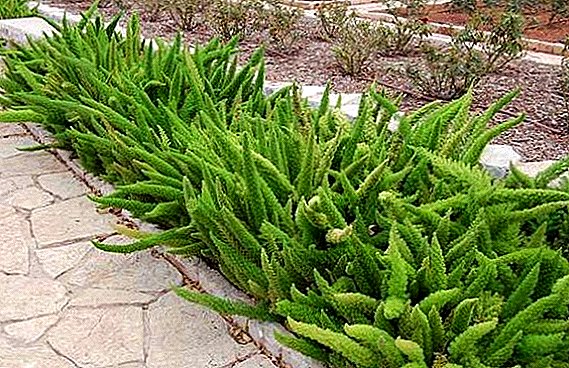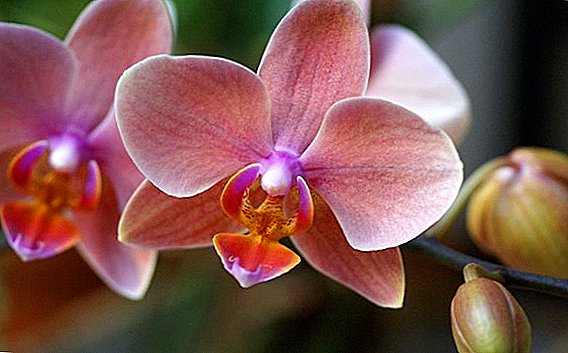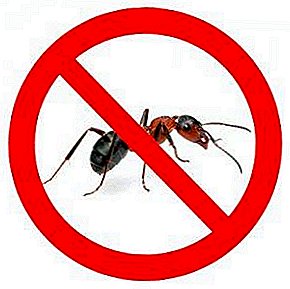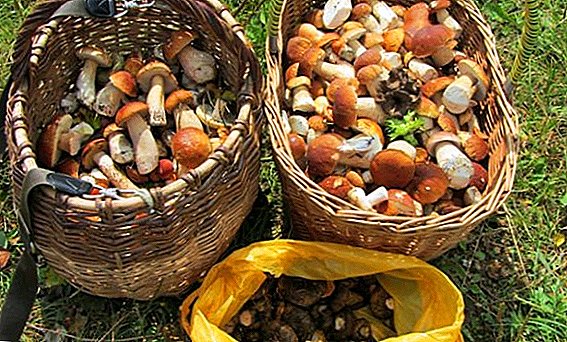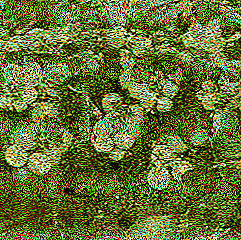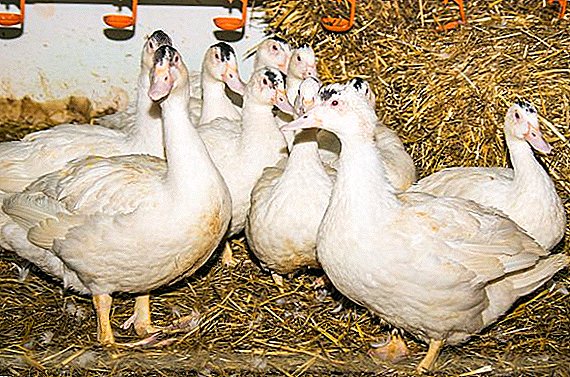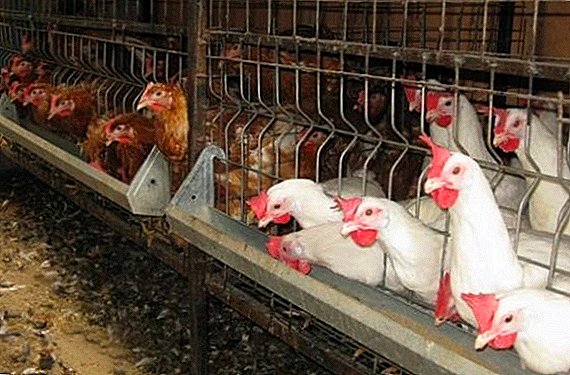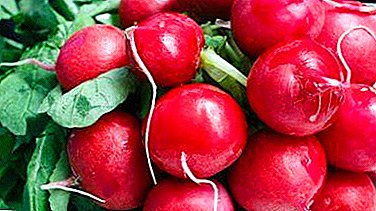
Before planting any plants in front of a gardener, the question always arises as to which species to choose and what are its pros and cons.
Many people want to plant radishes in the garden, but are lost in the abundance of varieties. Therefore, this article describes the characteristics of the radish variety “Heat”, so that gardeners will learn more about it. The variety is quite unpretentious, it ripens very quickly, shoots appear in a few days, and its incredible taste is difficult to confuse with other varieties of this vegetable.
Detailed characteristics and description of the variety
- Appearance. This variety of radish has a round root shape with a diameter of about 3-3.5 cm.The mass of each fruit is 25-30 g. The surface of the radish is red, crimson in color, and inside the flesh is white and dense. The taste is slightly spicy.
The sprouts are large, lush leaves of light green and pale green.
 This variety is remarkable because it contains a large amount of vitamin C.
This variety is remarkable because it contains a large amount of vitamin C. - Sowing time “Heat” is an early ripe and fruitful variety, therefore the most suitable time for sowing is the end of spring-beginning of summer, but radishes can be planted before winter. For this quality, it is popular with gardeners.
- What is the yield of 1 ha. With good care and processing from 1 hectare you can get a crop weighing 25 tons.
- Where it is recommended to grow. The best places for growing this radish are greenhouse or open ground. Here it is easy to take care of him, there are no special problems. In contrast, growing at home requires the gardener to take great care of the plants, since it is very difficult to provide the right temperature and conditions. Root crops can be deformed, become flabby, which, of course, will affect the final impression.
- Disease resistance. “Heat” is a variety of tasty, resistant to tsvetushnosti and various diseases, radish with high yields. Therefore, he is very fond of both beginners and experienced gardeners.
- Ripening. One of the main advantages of “Heat” is its fast ripening. It is only 18 days! It can be sown almost every 20 days and receive tasty fruits. It is only necessary to change the beds each time and ensure that the related species did not grow in the ground before.
Turnip, daikon, turnip or cabbage are bad neighbors for radish. The soil in which these vegetables grew can infect a new “tenant” with common diseases and pests.
- What kind of soil prefers. Tomatoes, cucumbers, beans and potatoes are considered the best predecessors for planting radishes. Earth is better to use a neutral or slightly acidic, it should be light and loose. In it you can make humus, ash, or pour ammonium nitrate, mullein for better growth.
Breeding history
This variety was grown by gardeners of Vitenko Experimental Station of Horticulture and Vegetable Growing named after I.V. Michurin Lithuanian Research Institute of Agriculture from a sample from Estonia. It was introduced into the Russian State Register in 1956, and in 1965 it was zoned.
Difference from other types of radish
Compared with other types of radish, “Heat” is a rather small variety in size, but its undoubted advantage is very rapid ripening. All types of radish vary in shape and size, including the "heat."
is he has a bright crimson-red color and roundish shape, and other varieties differ in color (from yellow to black) and in form (from small round root crops to long and large specimens).
A photo
Here you can see photos of this type of root.





Advantages and disadvantages
Advantages:
- Radish ripens very quickly and makes it possible to harvest several times, albeit from different beds.
- It has a peculiar taste.
- “Heat” needs only to be loosened and watered in time, otherwise he does not need serious concern.
- This variety is resistant to many diseases, marksmanship, sudden temperature changes and the formation of voids in the roots.
- Known for its high content of vitamin C, which makes roots not only tasty, but also useful.
- Radish has a beautiful shape and bright color.
Disadvantages:
- This variety is quite bad tolerates late frost.
- In view of the early ripening, already harvested radishes cannot be kept longer than 2.5-3 weeks, which makes storage difficult.
Application
In addition to the obvious consumption of food, due to the large harvest, uncomplicated care and taste, many gardeners grow Heat and sell to stores or sell them personally.
Planting and care
 Sow radish "Heat" can be from April to Augustthat allows you to grow more volumes of the product.
Sow radish "Heat" can be from April to Augustthat allows you to grow more volumes of the product.
- It is necessary to choose a lighted place on non-acidic soil for favorable growth.
- Plant one seed for every 2–3 cm of soil to a depth of 1.5–2 cm. At the optimum temperature of + 16 ° C, the first shoots will appear in a week.
- After that, radishes should be watered so that the ground is moist but not swampy.
- Periodically loosen the aisles, not allowing the crust to appear at the top of the soil.
When growing roots can stick out of the ground, which is the norm.
We offer to watch a video on how to plant radish Heat:
Harvesting and Storage
The first vegetables can be harvested as early as 17–20 days after germination.. The crop must be sorted and dried, and then sold or consumed. Radish is stored at room temperature for no more than 3 days, in a refrigerator or cellar - a couple of weeks.
This variety is not intended for freezing.
Diseases and pests
- The main pest is a bug called cruciferous (earthen) flea. His delicacy is most cruciferous plants.
The presence of the beetle can be identified by small and large holes in the leaves of the plant, and if the flea attacked the young shoots, the crop may die completely.
- The caterpillars of moth butterflies also cause damage. You can get rid of them with the help of folk remedies that do not harm a person during the subsequent eating of radish.
- The disease, under the short name Kila, is manifested in the formation of tubercles and growths on the root bark, yellowing and withering leaves. This disease is caused by a fungus, and is treated by watering the bushes with lime milk.
- One of the diseases is the unpleasant name "Black Leg". It is characterized by the appearance of spots on the stem and yellowing, twisting the leaves into a tube.
Of course, this is not the whole list of problems that may be faced by a gardener who has decided to grow "heat." There are also such diseases as, for example, gray rot, fusarium, powdery mildew, etc.
Prevention of various problems
 For, that the plant is not infected with diseases or does not tolerate damage from pests, it is necessary to follow the rules of crop rotation. However, sometimes it does not give proper results.
For, that the plant is not infected with diseases or does not tolerate damage from pests, it is necessary to follow the rules of crop rotation. However, sometimes it does not give proper results.
If the radish bushes are already affected, it is worth treating them with insecticides, or, at the request of the gardener, folk remedies.
Crop rotation is a consistent change of crops in a certain area. I.e Radish cannot be grown every year at the same place.. This reduces the fertility of the soil, and, subsequently, the harvest.
Similar types of radishes
Dabel, Heat and Presto are extremely similar due to the roughly ripeness, small size and taste with the speck. It is possible to confuse them with the view of “Ilka”, but this variety does not belong to early-ripening, but to mid-ripening species.
One of the best varieties of radish for growing is the “Heat”. The range of its application is very large, from selling to eating and making delicious dishes. Any gardener should try to grow this type, and after that - eat tasty and crispy root vegetables.


 This variety is remarkable because it contains a large amount of vitamin C.
This variety is remarkable because it contains a large amount of vitamin C.